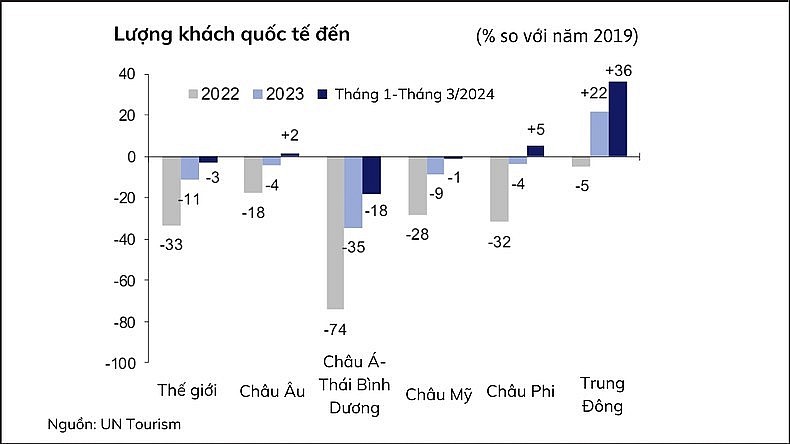
|
| Photo: HT |
International Tourism Bounces Back to Pre-Pandemic Levels
The latest data from UN Tourism reveals a promising rebound in global tourism. In the first quarter of 2024, international tourist arrivals reached an impressive 285 million, reflecting a 20% increase compared to the same period last year, and nearing pre-pandemic levels.
The Asia-Pacific region is leading this recovery, with international arrivals reaching 82% of pre-pandemic figures during the first quarter. Vietnam stands out as a top performer, recording a 3% increase in international visitors compared to 2019.
Other destinations that have witnessed significant growth in international visitors include the Maldives (+25%), Mongolia (+14%), Fiji (+13%), and Samoa (+4%). The Americas and Africa are also experiencing a strong comeback, with arrivals almost matching pre-pandemic levels.

|
| International tourist arrivals are on the rise, with the first quarter of 2024 showing a promising recovery. (Chart: UN Tourism) |
2024: Full Recovery Amid Challenges
UN Tourism predicts a full recovery for international tourism by 2024, driven by strong demand, improved air connectivity, and the resurgence of key markets like China and other Asian countries.
The UNWTO Tourism Confidence Index further reinforces this positive outlook, with a score of 130 for the summer months of May to August 2024, indicating a more optimistic sentiment than at the start of the year.
A majority of travel professionals (62%) anticipate an even better recovery during this period, while 31% foresee a performance similar to 2023. However, economic and geopolitical factors continue to present challenges to the industry, as highlighted by UN Tourism experts.
According to the IMF’s latest World Economic Outlook, the economic recovery is steady but slow, and varied across regions. Additionally, persistent inflation, high interest rates, volatile oil prices, and trade disruptions contribute to higher transportation and accommodation costs.
As a result of rising prices and economic uncertainties, tourists are expected to seek affordable destinations and opt for closer-to-home travel options.
UN Tourism emphasizes the importance of effective tourism management at the national and local levels to ensure that communities and people remain at the heart of this thriving industry.
Saigon among world’s fastest growing tourist cities
Ho Chi Minh City has been listed among the 15 fastest-growing tourist cities in the world by the Travelsupermarket website.








